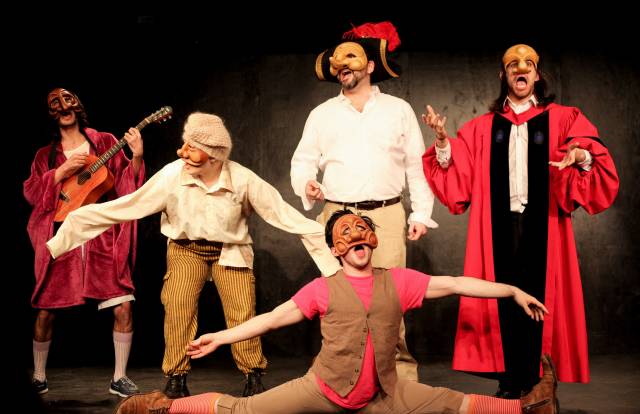

History is being rewritten from the point of view of the slaves who shaped it. The Department of Fools presents A History of Servitude, a series of vignettes performed in the style of commedia dell’arte, a type of street theatre developed during the Italian Renaissance. Using broad physical comedy and bawdy humor, commedia is mired in social satire and makes fun of societal archetypes. A History of Servitude shows how, throughout history, the slaves have upheld the masters, from the building of the pyramids to Christopher Columbus’ “discovery” of the New World. However, lest you think the servants are immune to mockery, they are foiled time and again by other foolishness.
A few commedia types prevail in A History of Servitude. One is the know-it-all scholar, Il Dottore (Matthew A.J. Gregory), who narrates in long flowing academic robes. Another type is the greedy old man Pantalone (an exceptional Yair Ben-Dor), who plays the decrepit Pharoah in ancient Egypt. Il Capitano (Alec Seymour), a Spanish captain full of boorish machismo, forms the basis of characters like Columbus. There are a few servant types, including Arlecchino and Colombina, that are not named in this performance, but who are often the ones doing most of the mocking. Company members Gjermund Gjesme and Ben Rademacher perform a hilarious Weekend at Bernie’s send-up as Egyptian slaves who use a lifeless Pantalone/Pharoah as a puppet during a salacious medical examination.
The basis of the different commedia archetypes is mask, particularly those that exaggerate the features and hide most of the face except for the eyes and mouth. The masks in A History of Servitude are wonderfully grotesque and are used well by the cast. They can make the characters look sad, greedy, lewd, stupid and a whole range of other expressions. The actors also exaggerate their voices for comic effect, going high pitched when playing a female and using a rasping old man voice when playing Pantalone.
Another feature of commedia is improvisation, which the cast does to varying degrees of success. At one point, an audience member spins a wheel to determine which historical figure or event they will improvise. The wheel chose Hillary Clinton and the players performed a weak spoof of Bill trying to hide from Hillary after she loses the election to Donald Trump. However, I enjoyed the timely references as they made the older play style more relevant.
Commedia also often incorporates song and dance numbers. One highlight of the show is when The Department of Fools’ women (Rotem Weiner, Silvia Morigi, and Anna Tempte) show their outrage on behalf of all the underappreciated women in history in a wonderful tune celebrating history changing women like Harriet Tubman and Albert Einstein’s wife, Mileva Maric, who some believe contributed to his theory of relativity. Other popular songs like “New York, New York” are peppered throughout the show.
A History of Servitude provides an interesting blend of commedia dell’arte and modern street theatre with its mix of broad comedy, improv and mask work. I enjoyed watching The Department of Fools make fools of themselves and blast the masters in the process.